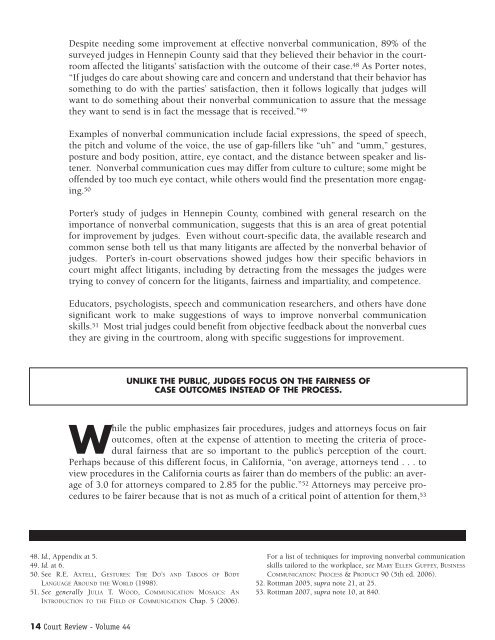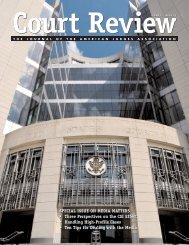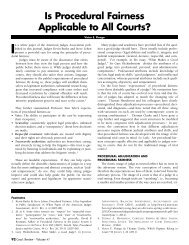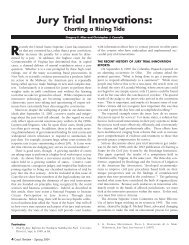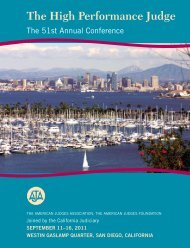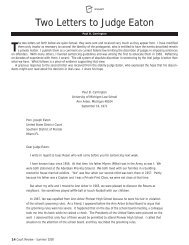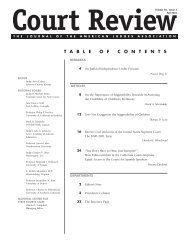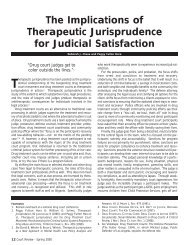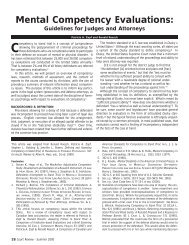Special Issue on Procedural Fairness - American Judges Association
Special Issue on Procedural Fairness - American Judges Association
Special Issue on Procedural Fairness - American Judges Association
- No tags were found...
You also want an ePaper? Increase the reach of your titles
YUMPU automatically turns print PDFs into web optimized ePapers that Google loves.
Despite needing some improvement at effective n<strong>on</strong>verbal communicati<strong>on</strong>, 89% of thesurveyed judges in Hennepin County said that they believed their behavior in the courtroomaffected the litigants’ satisfacti<strong>on</strong> with the outcome of their case. 48 As Porter notes,“If judges do care about showing care and c<strong>on</strong>cern and understand that their behavior hassomething to do with the parties’ satisfacti<strong>on</strong>, then it follows logically that judges willwant to do something about their n<strong>on</strong>verbal communicati<strong>on</strong> to assure that the messagethey want to send is in fact the message that is received.” 49Examples of n<strong>on</strong>verbal communicati<strong>on</strong> include facial expressi<strong>on</strong>s, the speed of speech,the pitch and volume of the voice, the use of gap-fillers like “uh” and “umm,” gestures,posture and body positi<strong>on</strong>, attire, eye c<strong>on</strong>tact, and the distance between speaker and listener.N<strong>on</strong>verbal communicati<strong>on</strong> cues may differ from culture to culture; some might beoffended by too much eye c<strong>on</strong>tact, while others would find the presentati<strong>on</strong> more engaging.50Porter’s study of judges in Hennepin County, combined with general research <strong>on</strong> theimportance of n<strong>on</strong>verbal communicati<strong>on</strong>, suggests that this is an area of great potentialfor improvement by judges. Even without court-specific data, the available research andcomm<strong>on</strong> sense both tell us that many litigants are affected by the n<strong>on</strong>verbal behavior ofjudges. Porter’s in-court observati<strong>on</strong>s showed judges how their specific behaviors incourt might affect litigants, including by detracting from the messages the judges weretrying to c<strong>on</strong>vey of c<strong>on</strong>cern for the litigants, fairness and impartiality, and competence.Educators, psychologists, speech and communicati<strong>on</strong> researchers, and others have d<strong>on</strong>esignificant work to make suggesti<strong>on</strong>s of ways to improve n<strong>on</strong>verbal communicati<strong>on</strong>skills. 51 Most trial judges could benefit from objective feedback about the n<strong>on</strong>verbal cuesthey are giving in the courtroom, al<strong>on</strong>g with specific suggesti<strong>on</strong>s for improvement.UNLIKE THE PUBLIC, JUDGES FOCUS ON THE FAIRNESS OFCASE OUTCOMES INSTEAD OF THE PROCESS.While the public emphasizes fair procedures, judges and attorneys focus <strong>on</strong> fairoutcomes, often at the expense of attenti<strong>on</strong> to meeting the criteria of proceduralfairness that are so important to the public’s percepti<strong>on</strong> of the court.Perhaps because of this different focus, in California, “<strong>on</strong> average, attorneys tend . . . toview procedures in the California courts as fairer than do members of the public: an averageof 3.0 for attorneys compared to 2.85 for the public.” 52 Attorneys may perceive proceduresto be fairer because that is not as much of a critical point of attenti<strong>on</strong> for them, 5348. Id., Appendix at 5.49. Id. at 6.50. See R.E. AXTELL, GESTURES: THE DO’S AND TABOOS OF BODYLANGUAGE AROUND THE WORLD (1998).51. See generally JULIA T. WOOD, COMMUNICATION MOSAICS: ANINTRODUCTION TO THE FIELD OF COMMUNICATION Chap. 5 (2006).For a list of techniques for improving n<strong>on</strong>verbal communicati<strong>on</strong>skills tailored to the workplace, see MARY ELLEN GUFFEY, BUSINESSCOMMUNICATION: PROCESS & PRODUCT 90 (5th ed. 2006).52. Rottman 2005, supra note 21, at 25.53. Rottman 2007, supra note 10, at 840.14 Court Review - Volume 44


